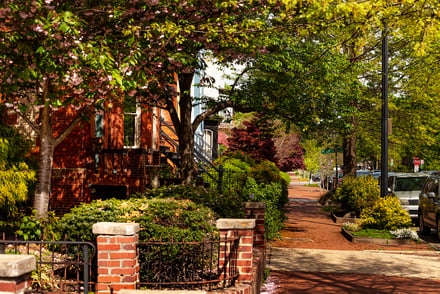The exposed bricks on DC's historic homes are a statement of quality, craftsmanship, and elegance. On the interior, an exposed brick wall is both timeless and harmonious with the age of the home, offering warmth and ambiance. However, this winter's weather has been erratic and wet, and when those bricks crumble and deteriorate, the look quickly becomes troubling.
This winter's wet weather, with frequent spells of freezing rapidly followed by warm thawing temperatures, can cause dust, cracks, missing chunks, and mortar gaps in brick masonry. These look unkempt and can sometimes be dangerous. If your historic home is suffering from crumbling bricks, they need to be repaired in the right way to prevent further damage.
Water Is the Likely Culprit
Crumbling bricks on houses built before the 1930s are cause for concern. These homes rarely have any additional internal wall supports, like steel rods. Instead, the house's structural integrity rests with the strength of the brick and mortar. This is true for the exterior and the interior side of an exposed brick wall.
When bricks fall apart, it often begins with the mortar. Weakened, missing, or crumbling mortar will allow water to seep between the bricks. An early sign of water infiltration is efflorescence or a fuzzy coating on your brick that may look like white fur. The surface of the brick flakes or breaks off when the water damage is severe enough. In cold climates, when the water in the brick freezes, it expands and forces the face of the brick to pop off. This is called spalling. Once this happens, the remaining damaged brick falls apart, leaving behind crumbling bricks.
Why Else Do Bricks Fall Apart?
Many cases of crumbling brick, both interior, and exterior, can be traced to water infiltration from crumbling or missing mortar. However, other factors can contribute to crumbling or spalling brick and mortar, including:
- Pressure washing: Not all bricks are a uniform hardness throughout. If high-velocity pressure washing or sandblasting damage the hardest exterior layer (as it will), the softer core is more likely to be susceptible to further damage.
- Improper sealants: Bricks can be sealed against the elements, but the sealant must be air permeable. A non-breathable sealant will trap water inside your bricks, making them vulnerable to spalling.
Correcting Crumbling Bricks with Tuckpointing
A restoration specialist can determine the extent of the damage by measuring the depth and extent of spalling. Although all spalling requires repair, extreme cases will require more intensive restoration. Experienced masons can replace damaged bricks with matching mortar. It is important to complete the repair with mortar and bricks compatible with the originals. New construction uses a different type of mortar that doesn't work with historical homes and risks causing further structural instability.
Sourcing bricks isn't always necessary, as some slightly damaged bricks can be carefully removed and turned around. The intact surface functions just as well as if it were new. Once the bricks are accounted for, using historically accurate mortar and mortar techniques ensures the entire structure will again be strong and structurally stable.
The Tuckpointing Experts
Historic homes require occasional maintenance of their mortar joints to ensure water stays out of the brick structure. Tuckpointing prevents water infiltration and crumbling bricks. An expert craftsperson can restore the structure when water damage is already present.
Renaissance Development is the leader in historic brick building preservation and restoration, using traditional methods and materials to ensure longevity and structural integrity. Contact us today to discuss solutions for your crumbling bricks and tuckpointing maintenance.
2/10/22 3:25 PM


